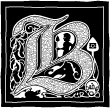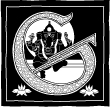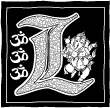Glossary
Śabda Kośaḥ शब्द कौशः
 aadheenam: ஆதீனம் A Śaivite Hindu monastery and temple complex in the South Indian Śaiva Siddhānta tradition. The aadheenam head is called the guru mahāsannidhānam or aadheenakarthar.§
aadheenam: ஆதீனம் A Śaivite Hindu monastery and temple complex in the South Indian Śaiva Siddhānta tradition. The aadheenam head is called the guru mahāsannidhānam or aadheenakarthar.§
Absolute: Lower case (absolute): real, not dependent on anything else, not relative. Upper case (Absolute): Ultimate Reality, the unmanifest, unchanging and transcendent Paraśiva. See: Paraśiva.§
āchārya: आचार्य A highly respected teacher.§
actinic: Spiritual, creating light. Adjective derived from the Greek aktis, “ray.” Of or pertaining to consciousness in its pure, unadulterated state. Actinic force is the superconscious mind and not a force which comes from the superconcious mind. Commonly known as life, spirit, it can be seen as the light in man’s eyes; it is the force that leaves man when he leaves his odic physical body behind. It is not opposite to odic force, it is different than odic force as light is different than water but shines through it. Actinic force flows freely through odic force. See: kośa.§
advaita: अदैत “Non-dual; not twofold.” Nonduality or monism. The doctrine that Ultimate Reality consists of a one principle substance, or God. Opposite of dvaita, dualism. See: dvaita-advaita, Vedānta.§
Advaita Īśvaravāda: अदैत ईउवरवाद “Nondual and Personal-God-as-Ruler doctrine,” monistic theism. The philosophy of the Vedas and Śaiva Āgamas, which believes in the ultimate oneness of all things and in the reality of the personal Deity.§
Advaita Īśvaravādin: अदैत ईउवरवादिन् A follower of Advaita Īśvaravāda.§
Advaita Siddhānta: अदैत सिद्धान्त “Nondual perfect conclusions.” Śaivite philosophy codified in the Āgamas which has at its core the nondual (advaitic) identity of God, soul and world. with a strong emphasis on internal and external worship, yoga sādhanas and tapas. Advaita Siddhānta is a term used in South India to distinguish Tirumular’s school from the pluralistic Siddhānta of Meykandar and Aghorasiva. It is the philosophy of this contemporary Hindu catechism.§
Āgama: आगम The tradition that which has “come down.” An enormous collection of Sanskrit scriptures which, along with the Vedas, are revered as śruti (revealed scripture). The primary source and authority for ritual, yoga and temple construction.§
agni: अग्नि “Fire.” 1) One of the five elements, pañchabhūta. 2) God of the element fire, invoked through Vedic ritual known as yajña, agnikāraka, homa and havana; the divine messenger who receives prayers and oblations and conveys them to the heavenly spheres. See: yajña.§
ahiṁsā: अहिंसा “Noninjury,” nonviolence or nonhurtfulness. Not causing harm to others, physically, mentally or emotionally. See: yama-niyama.§
ājñā chakra: आजाचक्र “Command wheel.” The third-eye center. See: chakra.§
ākāśa: आकाश “Space.” The sky. Free, open space. Ether, the fifth and most subtle of the five elements—earth, air, fire, water and ether. Empirically, the rarefied space or ethereal fluid plasma that pervades the universes, inner and outer. Esoterically, mind, the superconscious strata holding all that exists and all that potentially exists, wherein all happenings are recorded and can be read by clairvoyants.§
all-pervasive: Diffused throughout or existing in every part of the universe.§
anāhata chakra: अनाहतचक्र “Wheel of unstruck [sound].” The heart center. See: chakra.§
ānanda: आनन्द “Bliss.” The pure joy—ecstasy or enstasy—of God-consciousness or spiritual experience.§
ānandamaya kośa: आनन्दमयकोश “Bliss body.” The body of the soul, which ultimately merges with Śiva. See: kośa, soul.§
āṇava mala: आणवमल “Impurity of smallness; finitizing principle.” God’s individualizing veil of duality that enshrouds the soul. It is the source of finitude and ignorance, the most basic of the three bonds (āṇava, karma, māyā) which temporarily limit the soul.§
antyeshṭi: Alir���O� “Last rites.” Funeral.§
anugraha śakti: अनुग्रहशक्ति “Graceful or favoring power.” Revealing grace. God Śiva’s power of illumination, through which the soul is freed from the bonds of āṇava, karma and māyā and ultimately attains liberation, moksha. Specifically, anugraha descends on the soul as śaktipāta, the dīkshā (initiation) from a satguru. Anugraha is a key concept in Śaiva Siddhānta. It comes when āṇava mala, the shell of finitude which surrounds the soul, reaches a state of ripeness, malaparipāka. See: grace, śaktinipāta.§
ārjava: आर्जव “Steadfastness.” See: yama-niyama.§
arul: அருள் “Grace.” The third of the three stages of the sakala avasthai when the soul yearns for the grace of God, śaktinipāta. At this stage the soul seeks pati-jñānam, knowledge of God. See: pati-jñānam, sakala avasthā, śaktinipāta.§
āsana: आसान “Seat; posture.” In haṭha yoga, āsana refers to any of numerous poses prescribed to balance and tune up the subtle energies of mind and body for meditation and to promote health and longevity.§
ashṭāṅga yoga: अष्टाङ्गयोग “Eight-limbed union.” The classical rāja yoga system of eight progressive stages to Illumination: 1) —yama: “Restraint.” Virtuous and moral living 2) —niyama: “Observance.” Religious practices which cultivate the qualities of the higher nature. 3) —āsana: “Seat or posture.” 4) —prāṇāyāma: “Mastering life force.” Breath control. 5) —pratyāhāra: “Withdrawal.” Withdrawing consciousness from the physical senses. 6) —dhāraṇā: “Concentration.” Guiding the flow of consciousness. 7) —dhyāna: “Meditation.” 8) —samādhi: “Enstasy,” “sameness, contemplation/realization.” See: yoga.§
āśrama: आश्रम “Place of striving.” Hermitage; order of the life. Holy sanctuary; the residence and teaching center of a sādhu, saint, swāmī, ascetic or guru; often includes lodging for students. Also names life’s four stages.§
asteya: अस्तेय “Nonstealing.” See: yama-niyama.§
āstikya: आस्तिक्य “Faith.” See: yama-niyama.§
astral body: The subtle, nonphysical body (sūkshma śarīra) in which the soul functions in the astral plane, the inner world also called Antarloka. See: kośa, soul.§
astral plane (or world): The subtle world, or Antarloka, spanning the spectrum of consciousness from the viśuddha chakra in the throat to the pātāla chakra in the soles of the feet. In the astral plane, the soul is enshrouded in the astral body, called sūkshma śarīra. See: astral body, loka, three worlds.§
asura: असुर “Evil spirit; demon.” (Opposite of sura: “deva; God.”) A being of the lower astral plane, Naraka. Asuras can and do interact with the physical plane, causing major and minor problems in people’s lives. Asuras do evolve and do not remain permanently in this state.§
atala chakra: अतल चक्र “Bottomless region.” The first chakra below the mūlādhāra, at the hip level. Region of fear and lust. See: chakra, Narakaloka.§
Aum: ॐ or औम् Often spelled Om. The mystic syllable of Hinduism, associated with Lord Gaṇeśa, placed at the beginning of sacred writings. In common usage in several Indian languages, aum means “yes, verily” or “hail.” See: Praṇava.§
aura: The luminous colorful field of subtle energy radiating within and around the human body. The colors change according to the ebb and flow of one’s state of consciousness, thoughts, moods and emotions.§
avasthā: अवस्था (Tamil: avasthai.) “Condition” or “state” of consciousness or experience. 1) Any of three stages of the soul’s evolution from the point of its creation to final merger in the Primal Soul. 2) The states of consciousness as discussed in the Māṇḍūkya Upanishad: jāgrat (or vaiśvānara), “wakefulness;” svapna (or taijasa), “dreaming;” sushupti, “deep sleep;” and turīya, “the fourth” state, of superconsciousness. A fifth state, “beyond turīya,” is turīyātīta. See: kevala avasthā, sakala avasthā, śuddha avasthā.§
awareness: Individual consciousness, perception, knowing; the witness of perception, the “inner eye of the soul.” Sākshin or chit in Sanskrit.§
āyurveda: आयुर्वेद “Science of life.” A holistic system of medicine and health native to ancient India, seeking āyus, “longevity,” and ārogya, “diseaselessness,” to facilitate spiritual progress. Focus is on balancing energies through methods suited to the individual’s constitution, lifestyle and nature.§
Ayyappan: ஐயப்பன் Popular God of a recently formed sect that focuses on pilgrimage to the top of Sabarimalai, a sacred hill in Kerala.§
 Being: When capitalized, being refers to God’s essential divine nature—Pure Consciousness, Absolute Reality and Primal Soul (God’s nature as a divine Person). Lower case being refers to the essential nature of a person, that within which never changes; existence. See: Śiva.§
Being: When capitalized, being refers to God’s essential divine nature—Pure Consciousness, Absolute Reality and Primal Soul (God’s nature as a divine Person). Lower case being refers to the essential nature of a person, that within which never changes; existence. See: Śiva.§
bhajana: भजन Spiritual song. Individual or group singing of devotional songs, hymns and chants.§
bhūmikā: भूमिका “Earth; ground; soil.” Preface; introduction to a book. From bhū, “to become, exist; arise, come into being.”§
Bodhinatha (Bodhinātha): போதிநாத “Lord of Wisdom.” The current preceptor of the Nandinātha Sampradāya’s Kailāsa Paramparā, and Guru Mahāsannidhānam of Kauai Aadheenam, ordained by Satguru, Sivaya Subramuniyaswami in 2001.§
brahmachārī: ब्रह्मचारी An unmarried male spiritual aspirant who practices continence, observes religious disciplines, including sādhana, devotion and service and who may be under simple vows. Also names one in the student stage, age, or until marriage.§
brahmachāriṇī: ब्रह्मचारिणी Feminine counterpart of brahmachārī.§
brahmacharya: ब्रह्मचर्य See: yama-niyama.§
 chakra: चक्र “Wheel.” Any of the nerve plexes or centers of force and consciousness located within the inner bodies of man. In the physical body there are corresponding nerve plexuses, ganglia and glands. The seven principal chakras are situated along the spinal cord from the base to the cranial chamber. Additionally, seven chakras exist below the spine. They are seats of instinctive consciousness, the origin of jealousy, hatred, envy, guilt, sorrow, etc. They constitute the lower or hellish world, called Naraka or pātāla. Thus, there are 14 major chakras in all. The seven upper chakras are: 1) mūlādhāra (base of spine): memory, time and space; 2) svādhishṭhāna (below navel): reason; 3) maṇipūra (solar plexus): willpower; 4) anāhata (heart center): direct cognition; 5) viśuddha (throat): divine love; 6) ājñā (third eye): divine sight; 7) sahasrāra (crown of head): illumination, Godliness. The seven lower chakras are 1) atala (hips): fear and lust; 2) vitala (thighs): raging anger; 3) sutala (knees): retaliatory jealousy; 4) talātala (calves): prolonged mental confusion; 5) rasātala (ankles): selfishness; 6) mahātala (feet): absence of conscience; 7) pātāla (located in the soles of the feet): murder and malice. See: Narakaloka.§
chakra: चक्र “Wheel.” Any of the nerve plexes or centers of force and consciousness located within the inner bodies of man. In the physical body there are corresponding nerve plexuses, ganglia and glands. The seven principal chakras are situated along the spinal cord from the base to the cranial chamber. Additionally, seven chakras exist below the spine. They are seats of instinctive consciousness, the origin of jealousy, hatred, envy, guilt, sorrow, etc. They constitute the lower or hellish world, called Naraka or pātāla. Thus, there are 14 major chakras in all. The seven upper chakras are: 1) mūlādhāra (base of spine): memory, time and space; 2) svādhishṭhāna (below navel): reason; 3) maṇipūra (solar plexus): willpower; 4) anāhata (heart center): direct cognition; 5) viśuddha (throat): divine love; 6) ājñā (third eye): divine sight; 7) sahasrāra (crown of head): illumination, Godliness. The seven lower chakras are 1) atala (hips): fear and lust; 2) vitala (thighs): raging anger; 3) sutala (knees): retaliatory jealousy; 4) talātala (calves): prolonged mental confusion; 5) rasātala (ankles): selfishness; 6) mahātala (feet): absence of conscience; 7) pātāla (located in the soles of the feet): murder and malice. See: Narakaloka.§
clairaudience: “Clear-hearing.” Psychic or divine hearing, divyaśravana. The ability to hear the inner currents of the nervous system, the Aum and other mystic tones. Hearing in one’s mind the words of inner-plane beings or earthly beings not physically present. Also, hearing the highe “eee” sound, or nādanāḍī śakti, through the day or while in meditation.§
clairvoyance: “Clear-seeing.” Psychic or divine sight, divyadṛishṭi. The ability to look into the inner worlds and see auras, chakras, nāḍīs, thought forms, nonphysical people and subtle forces.§
concentration: Uninterrupted and sustained attention. See: ashṭaṅga yoga.§
conscious mind: The external, everyday state of consciousness. See: mind.§
consciousness: Chitta or chaitanya. 1) A synonym for mind-stuff, chitta; or 2) the condition or power of perception, awareness, apprehension.§
contemplation: Religious or mystical absorption beyond meditation.§
cosmos: The universe, or whole of creation, especially with reference to its order, harmony and completeness. See: loka, three worlds.§
 Dakshiṇāmūrti: दश्रिणामूर्ति “South-facing form.” Lord Śiva depicted sitting under a banyan tree, silently teaching four ṛishis at His feet. See: Śiva.§
Dakshiṇāmūrti: दश्रिणामूर्ति “South-facing form.” Lord Śiva depicted sitting under a banyan tree, silently teaching four ṛishis at His feet. See: Śiva.§
dāna: दान Generosity, giving. See: yama-niyama.§
daśama bhāga vrata: दशमभागव्रत “One-tenth-part vow.” A promise that tithers make before God, Gods and their family or peers to tithe regularly.§
daśamāṁśa: दशमांश “One-tenth sharing.” The traditional Hindu practice of tithing, giving one-tenth of one’s income to a religious institution.§
dayā: दया “Compassion.” See: yama-niyama.§
Deity: “God.” The image or mūrti installed in a temple or the Mahādeva the mūrti represents.§
deva: देव “Shining one.” A being inhabiting the higher astral plane, in a subtle, nonphysical body. Deva is also used in scripture to mean “God or Deity.”§
Devaloka: देवलोक “Plane of radiant beings.” A synonym of Maharloka, the higher astral plane, realm of anāhata chakra. See: loka.§
devonic: Of or relating to the devas or their world.§
dhāraṇā: धारणा “Concentration.” From dhṛi, “to hold.” See: ashṭaṅga yoga.§
dharma: धर्म From dhṛi, “to sustain; carry, hold.” Hence dharma is “that which contains or upholds the cosmos.” Dharma has manifold meanings, including: divine law, ethics, law of being, way of righteousness, religion, duty, virtue, justice, goodness and truth. Essentially, dharma is the orderly fulfillment of an inherent nature or destiny. Relating to the soul, it is the mode of conduct most conducive to spiritual advancement, the right and righteous path. There are four principal kinds of dharma, known collectively as chaturdharma: “four religious laws.” 1) ṛita: “Universal law.” The laws of being and nature that contain and govern all forms, functions and processes, from galaxy clusters to the power of mental thought and perception. 2) varṇa dharma: “Law of one’s kind.” Social duty. Varṇa can mean “race, tribe, appearance, character, color, social standing, etc.” Obligations and responsibilities within one’s nation, society, community, class, occupational subgroup and family. 3) āśrama dharma: “Duties of life’s stages.” Human or developmental dharma, fulfilling of the duties of the four stages of life—brahmachārī (student), gṛihastha (householder), vānaprastha (elder advisor) and sannyāsa (religious solitaire). 4) svadharma: “Personal obligations or duty.” One’s perfect individual pattern through life, according to one’s own particular physical, mental and emotional nature, the application of dharma, dependent on personal karma, reflected in one’s race, community, physical characteristics, health, intelligence, skills and aptitudes, desires and tendencies, religion, sampradāya, family and guru.§
dhṛiti: धूति “Steadfastness.” See: yama-niyama.§
dhyāna: ध्यान “Meditation.” See: ashṭaṅga yoga.§
dīkshā: दीक्षा “Initiation.” Solemn induction by which one is entered into a new realm of spiritual awareness and practice by a teacher or preceptor through bestowing of blessings. Denotes initial or deepened connection with the teacher and his lineage and is usually accompanied by ceremony.§
Dīpāvalī: दीपावली “Row of Lights.” A very popular home and community festival in October/November when Hindus of all denominations light oil or electric lights and set off fireworks in a joyful celebration of the victory of good over evil and light over darkness.§
disincarnate: Having no physical body; of the astral plane; astral beings. See: astral body, astral plane.§
dvaita-advaita: द्वैत-अद्वैत “Dual-nondual; twoness-not twoness.” Among the most important categories in the classification of Hindu philosophies. Dvaita and advaita define two ends of a vast spectrum. —dvaita: The doctrine of dualism, according to which reality is ultimately composed of two irreducible principles, entities, truths, etc. God and soul, for example, are seen as eternally separate. —dualistic: Of or relating to dualism, concepts, writings, theories which treat dualities (good-and-evil, high-and-low, them-and-us) as fixed, rather than transcendable. —pluralism: A form of nonmonism which emphasizes three or more eternally separate realities, e.g., God, soul and world. —advaita: The doctrine of nondualism or monism, that reality is ultimately composed of one whole principle, substance or God, with no independent parts. In essence, all is God. —monistic theism: A dipolar view which encompasses both monism and dualism.§
dualism: See: dvaita-advaita.§
 ego: The external personality or sense of “I” and “mine.” Broadly, individual identity. In Śaiva Siddhānta and other schools, the ego is equated with the tattva of ahaṁkāra, “I-maker,” which bestows the sense of I-ness, individuality and separateness from God.§
ego: The external personality or sense of “I” and “mine.” Broadly, individual identity. In Śaiva Siddhānta and other schools, the ego is equated with the tattva of ahaṁkāra, “I-maker,” which bestows the sense of I-ness, individuality and separateness from God.§
eminent: High; above others in stature, rank or achievement.§
enlightenment: For Śaiva monists, Self Realization, samādhi without seed (nirvikalpa samādhi); the ultimate attainment, sometimes referred to as Paramātma darśana, or as ātma darśana, “Self vision.”§
existentialism: A philosophy that emphasizes the uniqueness and isolation of the individual experience in a hostile or indifferent universe, regards human existence as unexplainable, and stresses freedom of choice and responsibility for the consequences of one’s acts.§
existentialist: Pertaining to, or believing in, the philosophy of existentialism.§
 Gaṇeśa: गणेश “Lord of Categories.” Or: “Lord of attendants (gaṇa),” synonymous with Gaṇapati. Gaṇeśa is a Mahādeva, the beloved elephant-faced Deity honored by Hindus of every sect.§
Gaṇeśa: गणेश “Lord of Categories.” Or: “Lord of attendants (gaṇa),” synonymous with Gaṇapati. Gaṇeśa is a Mahādeva, the beloved elephant-faced Deity honored by Hindus of every sect.§
Gaṇeśa Chaturthī: गणेश चतुर्थी The birthday of Lord Gaṇeśa, a ten-day festival of August-September that culminates in a parade called Gaṇeśa Visarjana. It is a time of rejoicing, when all Hindus worship together.§
God: Supernal being. Either the Supreme God, Śiva, or one of the Mahādevas, great souls, who are among His creation.§
Goddess: Female representation or manifestation of Divinity; Śakti or Devī. Goddess can refer to a female perception or depiction of a causal-plane being (Mahādeva) in its natural state, which is genderless, or it can refer to an astral-plane being residing in a female astral body.§
Gods: Mahādevas, “great beings of light.” In Dancing with Śiva, the plural form of God refers to extremely advanced beings existing in their self-effulgent soul bodies in the causal plane.§
Gorakshanatha (Gorakshanātha): गोरक्षनाथ Profound siddha yoga master of the Ādinātha Sampradāya (ca 950). Expounder and foremost guru of Siddha Siddhānta Śaivism. He traveled and extolled the greatness of Śiva throughout North India and Nepal where he and his guru, Matsyendranatha, are still highly revered.§
God Realization: Direct and personal experience of the Divine within oneself. It can refer to either 1) savikalpa samādhi (“enstasy with form”) in its various levels, from the experience of inner light to the realization of Satchidānanda, pure consciousness, or 2) nirvikalpa samādhi (“enstasy without form”), union with the transcendent Absolute, Paraśiva, the Self God, beyond time, form and space. In Yoga’s Forgotten Foundation, the expression God Realization is used to name both of the above samādhis, whereas Self Realization refers only to nirvikalpa samādhi.§
grace: “Benevolence, love, giving,” from the Latin gratia, “favor,” “goodwill.” God’s power of revealment, anugraha śakti (“kindness, showing favor”), by which souls are awakened to their true, Divine nature. Grace in the unripe stages of the spiritual journey is experienced by the devotee as receiving gifts or boons, often unbidden, from God. The mature soul finds himself surrounded by grace. He sees all of God’s actions as grace, whether they be seemingly pleasant and helpful or not. Grace is not only the force of illumination or revealment. It also includes Śiva’s other four powers—creation, preservation, destruction and concealment—through which He provides the world of experience and limits the soul’s consciousness so that it may evolve. More broadly, grace is God’s ever-flowing love and compassion, kāruṇya, also known as kṛipā (“tenderness, compassion”) and prasāda (literally, “clearness, purity”). The concealment power is known as veiling grace, God’s power to obscure the soul’s divine nature, or tirodhāna śakti, the particular energy of Śiva that binds the three bonds of āṇava, karma, māyā to the soul. It is a purposeful limiting of consciousness to give the opportunity to the soul to grow and mature through experience of the world.§
guṇa: गुण “Strand; quality.” The three constituent principles of prakṛiti, primal nature. The three guṇas are —sattva: Quiescent, rarified, translucent, pervasive, reflecting the light of Pure Consciousness. —rajas: “Passion,” inherent in energy, movement, action, emotion, life. —tamas: “Darkness,” inertia, density, the force of contraction, resistance and dissolution.§
guru: गुरु “Weighty one,” indicating an authority of great knowledge or skill. A teacher or guide in any subject, such as music, dance, sculpture, but especially religion. Often preceded by a qualifying prefix. Hence, kulaguru (family teacher), vīnaguru (vīṇa teacher) and satguru (spiritual preceptor). In astrology, guru names the planet Jupiter, also known as Bṛihaspati. According to the Advayatāraka Upanishad (14–18), guru means “dispeller (gu) of darkness (ru).”§
guru paramparā: गुरुपरंपरा “Preceptorial succession” (literally, “from one to another”). A line of spiritual gurus in authentic succession of initiation; the chain of mystical power and authorized continuity, passed from guru to guru. Cf: sampradāya.§
guru-śishya system: गुरुशिष्य “Master-disciple system.” An important education system of Hinduism whereby the teacher conveys his knowledge and tradition to a student. Such knowledge, whether it be Vedic-Āgamic art, architecture or spirituality, is imparted through the developing relationship between guru and disciple.§
 hatḥa yoga: हठयोग “Forceful yoga.” A system of physical and mental exercise developed in ancient times as a means of rejuvenation by ṛishis and tapasvins, used today in preparing the body and mind for meditation.§
hatḥa yoga: हठयोग “Forceful yoga.” A system of physical and mental exercise developed in ancient times as a means of rejuvenation by ṛishis and tapasvins, used today in preparing the body and mind for meditation.§
Haṭha Yoga Pradīpikā: हठयोगप्रदीपिका “Elucidation of_haṭha yoga.” A 14th-century text of 389 verses by Svatmarama Yogin that describes the philosophy and practices of haṭha yoga.§
heart chakra: Anāhata chakra. Center of direct cognition. See: chakra.§
hiṁsā: हिंसा “Injury; harm; hurt.” Injuriousness, hostility—mental, verbal or physical. See: ahiṁsā.§
Hindu: हिन्दु A follower of, or relating to, Hinduism. See: Hinduism.§
Hinduism (Hindu Dharma): हिन्दुधर्म India’s indigenous religious and cultural system, followed today by nearly one billion adherents, mostly in India, but with the large diaspora in many other countries. Also called Sanātana Dharma, “Eternal Religion” and Vaidika Dharma, “Religion of the Vedas.” It is a family of myriad faiths with four primary denominations: Śaivism, Vaishṇavism, Śāktism and Smārtism.§
homa: होम “Fire-offering.” A ceremony of offering oblations to the Gods through the medium of fire in a sanctified fire pit, homakuṇḍa, usually made of earthen bricks. Homa rites are enjoined in the Vedas, Āgamas and Dharma and Gṛihya Śāstras.§
hrī: ह्री “Remorse; modesty.” See: yama-niyama.§
 iḍā nāḍī: इडानाडी “Soothing channel.” The feminine psychic current flowing along the spine. See: kuṇḍalinī, nāḍī.§
iḍā nāḍī: इडानाडी “Soothing channel.” The feminine psychic current flowing along the spine. See: kuṇḍalinī, nāḍī.§
instinctive: “Natural” or “innate.” From the Latin instinctus, “impelling, instigating.” The drives and impulses that order the animal world and the physical and lower astral aspects of humans—for example, self-preservation, procreation, hunger and thirst, as well as the emotions of greed, hatred, anger, fear, lust and jealousy.§
instinctive mind: Manas chitta. The lower mind, which controls the basic faculties of perception, movement, as well as ordinary thought and emotion.§
internalized worship: Yoga. Worship or contact with God and Gods via meditation and contemplation rather than through external ritual.§
intuition (to intuit): Direct understanding or cognition, which bypasses the process of reason.§
invocation (to invoke): A “calling or summoning,” as to a God, saint, etc., for blessings and assistance. Also, a formal prayer or chant. See: mantra.§
Iraivan: இறைவன் “Worshipful one; divine one.” One of the most ancient Tamil appellations for God. See: San Marga Sanctuary.§
Iraivan Temple: See: San Marga Sanctuary.§
irul: இருள் “Darkness.” The first of three stages of the sakala avasthai where the soul’s impetus is toward pāśa-jñānam, knowledge and experience of the world. See: pāśa-jñānam, sakala avasthā.§
iruvinaioppu: இருவினையொப்பு “Balance.” The balance which emerges in the life of a soul in the stage of marul, or paśu-jñānam, the second stage of the sakala avasthai, when the soul turns toward the good and holy, becomes centered within himself, unaffected by the ups and downs in life. See: marul, paśu-jñānam, sakala avasthā.§
Īśvarapūjana: ईशवरपूजन “Worship.” See: yama-niyama.§
 jagadāchārya: जगदाचार्य “World teacher.”§
jagadāchārya: जगदाचार्य “World teacher.”§
japa: जप “Recitation.” Concentrated repeating of a mantra, silently or aloud, often counting on a mālā or strand of beads. A cure for pride and arrogance, jealousy, fear and confusion.§
jīva: जीव “Living, existing.” From jīv, “to live.” The individual soul, ātman, during its embodied state, bound by the three malas (āṇava, karma and māyā).§
jñāna: ज्ञान “Knowledge; wisdom.” The matured state of the soul. It is the wisdom that comes as an aftermath of the kuṇḍalinī breaking through the door of Brahman into the realization of Paraśiva, Absolute Reality. Jñāna is the awakened, superconscious state (kāraṇa chitta) flowing into daily life situations.§
jñāna dāna: ज्ञानदान “Gifts of wisdom.” The karma yoga of printing, sponsoring and distributing Hindu religious literature, pamphlets and books, free of charge as a way of helping others spiritually.§
jñānī: ज्ञानी “Sage.” Possessing jñāna. See: jñāna.§
jyotisha: ज्योतिष From jyoti, “light.” “The science of the lights (or stars),” Hindu astrology, analyzing events and circumstances, delineating character and determining auspicious moments, according to the positions and movements of heavenly bodies.§
 Kailasa (Kailāsa): कैलास “Crystalline” or “abode of bliss.” The Himalayan peak in Western Tibet; the earthly abode of Lord Śiva, a pilgrimage destination for Hindus and Tibetan Buddhists.§
Kailasa (Kailāsa): कैलास “Crystalline” or “abode of bliss.” The Himalayan peak in Western Tibet; the earthly abode of Lord Śiva, a pilgrimage destination for Hindus and Tibetan Buddhists.§
Kailāsa Paramparā: कैलासपरंपरा A spiritual lineage of 163 siddhas, a major stream of the Nandinātha Sampradāya, proponents of the ancient philosophy of monistic Śaiva Siddhānta. The first of these masters that history recalls was Maharishi Nandinatha (or Nandikesvara) 2,250 years ago, satguru to the great Tirumular, ca 200 BCE, and seven other disciples (as stated in the Tirumantiram). The lineage continued down the centuries and is alive today—the first recent siddha known being the “Rishi from the Himalayas,” so named because he descended from those holy mountains. In South India, he initiated Kadaitswami (ca 1810–1875), who in turn initiated Chellappaswami (1840–1915). Chellappan passed the mantle of authority to Sage Yogaswami (1872–1964), who in 1949 initiated Sivaya Subramuniyaswami (1927–2001), who in 2001 ordained the current preceptor, Satguru Bodhinatha Veylanswami (1942–). See: Nātha Sampradāya.§
Kali Yuga: कलियुग “Dark Age.” The Kali Yuga is the last age in the repetitive cycle of four phases of time our solar system passes through. It is comparable to the darkest part of the night, as the forces of ignorance are in full power and many subtle faculties of the soul are obscured.§
karma: कर्म “Action,” “deed.” 1) any act or deed; 2) the principle of cause and effect; 3) a consequence or “fruit of action” (karmaphala) or “after effect” (uttaraphala), which sooner or later returns upon the doer. What we sow, we shall reap in this or future lives. Selfish, hateful acts (pāpakarma or kukarma) will bring suffering. Benevolent actions (puṇyakarma or sukarma) will bring loving reactions. Karma is threefold: sañchita, prārabdha and kriyamāna. —sañchita karma: “Accumulated actions.” The sum of all karmas of this life and past lives. —prārabdha karma: “Actions begun; set in motion.” That portion of sañchita karma that is bearing fruit and shaping the events and conditions of the current life, including the nature of one’s bodies, personal tendencies and associations. —kriyamāna karma: “Being made.”§
karma yoga: कर्मयोग “Union through action.” Selfless service.§
Kauai Aadheenam: Monastery-temple complex founded by Sivaya Subramuniyaswami in 1970; international headquarters of Saiva Siddhanta Church.§
kośa: कोश “Sheath; vessel, container; layer.” Philosophically, five sheaths through which the soul functions simultaneously in the various planes or levels of existence. The kośas are —annamaya kośa: “Sheath composed of food.” The physical or odic body, coarsest of sheaths in comparison to the faculties of the soul, yet indispensable for evolution and Self Realization, because only within it can all fourteen chakras fully function. See: chakra. —prāṇamaya kośa: “Sheath composed of prāṇa (vital force).” The prāṇic or health body, or the etheric body or etheric double, coexisting within the physical body as its source of life, breath and vitality, and is its connection with the astral body. Prāṇa moves in the prāṇamaya kośa as five primary currents or vayus, “vital airs or winds.” Prāṇamaya kośa disintegrates at death along with the physical body. See: prāṇa —manomaya kośa: “Mind-formed sheath.” The lower astral body, from manas, “thought, will, wish.” The instinctive-intellectual sheath of ordinary thought, desire and emotion. The manomaya kośa takes form as the physical body develops and is discarded in the inner worlds before rebirth. —vijñānamaya kośa: “Sheath of cognition.” The mental or cognitive-intuitive sheath, also called the actinodic sheath. It is the vehicle of higher thought, vijñāna—understanding, knowing, direct cognition, wisdom, intuition and creativity. —ānandamaya kośa: “Body of bliss.” The intuitive-superconscious sheath or actinic-causal body. The inmost soul form (svarūpa), the ultimate foundation of all life, intelligence and higher faculties. Its essence is Parāśakti (Pure Consciousness) and Paraśiva (the Absolute). It is the soul itself, a body of light, also called kāraṇa śarīra, causal body, and karmāśaya, holder of karmas of this and all past lives. Kāraṇa chitta, “causal mind,” names the soul’s superconscious mind, of which Parāśakti (or Satchidānanda) is the rarified substratum.§
kevala avasthā: केवल अवस्था “Stage of oneness, aloneness.” (Tamil: avasthai.) In Śaiva Siddhānta, the first of three stages of the soul’s evolution, a state beginning with its emanation or spawning by Lord Śiva as an etheric form unaware of itself, a spark of the Divine shrouded in a cloud of darkness known as āṇava. Here the soul is likened to a seed hidden in the ground, yet to germinate and unfold its potential. See: sakala avasthā, śuddha avasthā.§
kriyā: क्रिया “Action.” 1) Doing of any kind. Specifically, religious action, especially rites or ceremonies. 2) Involuntary physical movements occuring during meditation that are pretended or caused by lack of emotional self-control or by the premature or unharnessed arousal of the kuṇḍalinī. 3) Haṭha yoga techniques for cleansing the mucous membranes. 4) The second stage of the Śaiva path, religious action, kriyā pāda. See: pāda.§
kriyā mārga: क्रियामार्ग See kriyā pāda.§
kriyā pāda: क्रियापाद “Stage of religious action; worship.” The stage of worship and devotion, second of four progressive stages of maturation on the Śaiva Siddhānta path of attainment. See: pāda.§
kshamā: क्षमा “Forebearance.” See: yama-niyama.§
kuṇḍalinī: कुण्डलिनी “She who is coiled; serpent power.” The primordial cosmic energy in every individual which, at first, lies coiled like a serpent at the base of the spine and eventually, through the practice of yoga, rises up the sushumṇā nāḍī. As it rises, the kuṇḍalinī awakens each successive chakra. Nirvikalpa samādhi, enlightenment, comes as it pierces through the door of Brahman at the core of the sahasrāra and enters! Kuṇḍalinī śakti then returns to rest in any one of the seven chakras. Śivasāyujya is complete when the kuṇḍalinī arrives back in the sahasrāra and remains coiled in this crown chakra.§
kuṇḍalinī yoga: कुण्डलिनीयोग “Uniting the serpent power.” Advanced meditative practices and sādhana techniques, a part of rāja yoga, performed to deliberately arouse the kuṇḍalinī power and guide it up the spine into the crown chakra, sahasrāra. In its highest form, this yoga is the natural result of sādhanas and tapas well performed, rather than a distinct system of striving and teaching in its own right.§
 liberal Hinduism: A synonym for Smārtism and the closely related neo-Indian religion. See: neo-Indian religion, Smārtism.§
liberal Hinduism: A synonym for Smārtism and the closely related neo-Indian religion. See: neo-Indian religion, Smārtism.§
liberation: Moksha, release from the bonds of pāśa, after which the soul is liberated from saṁsāra (the round of births and deaths). In Śaiva Siddhānta, pāśa is the threefold bondage of āṇava, karma and māyā, which limit and confine the soul to the reincarnational cycle so that it may evolve. Moksha is freedom from the fettering power of these bonds, which do not cease to exist, but no longer have the power to fetter or bind the soul.§
loka: लोक “World, habitat, realm, or plane of existence.” From loc, “to shine, be bright, visible.” A dimension of manifest existence; cosmic region. Each loka reflects or involves a particular range of consciousness. The three primary lokas are 1) —Bhūloka: “Earth world.” The world perceived through the five senses, also called the gross plane, as it is the most dense of the worlds. 2) —Antarloka: “Inner or in-between world.” Known in English as the subtle or astral plane, the intermediate dimension between the physical and causal worlds, where souls in their astral bodies sojourn between incarnations and when they sleep. 3) —Śivaloka: “World of Śiva,” and of the Gods and highly evolved souls. The causal plane, also called Kāraṇaloka, existing deep within the Antarloka at a higher level of vibration, it is a world of superconsciousness and extremely refined energy. It is the plane of creativity and intuition, the quantum level of the universe, where souls exists in self-effulgent bodies made of actinic particles of light. It is here that God and Gods move and lovingly guide the evolution of all the worlds and shed their ever-flowing grace. See: three worlds.§
 Mahādeva: महादेव “Great shining one; God.” Referring either to God Śiva or any of the highly evolved beings who live in the Śivaloka in their natural, effulgent soul bodies.§
Mahādeva: महादेव “Great shining one; God.” Referring either to God Śiva or any of the highly evolved beings who live in the Śivaloka in their natural, effulgent soul bodies.§
mahāsamādhi: महासमाधि “Great enstasy.” The death, or giving up of the physical body, of a great soul, an event occasioned by tremendous blessings. Also names the shrine in which the remains of a great soul are entombed. See: cremation, death.§
Mahāśivarātri: महाशिवरात्रि “Śiva’s great night.” Śaivism’s foremost festival, celebrated on the night before the new moon in February-March. Fasting and an all-night vigil are observed as well as other disciplines: chanting, praying, meditating and worshiping Śiva as the Source and Self of all that exists.§
mahātala chakra: महातल चक्र Sixth netherworld. Region of consciencelessness. See: chakra.§
mala: मल “Impurity.” An important term in Śaivism referring to three bonds, called pāśa—āṇava, karma, and māyā—which limit the soul, preventing it from knowing its true, divine nature.§
mālā: माला “Garland.” A strand of beads for holy recitation, japa, usually made of rudrāksha, tulasī, sandalwood or crystal. Also a flower garland.§
malaparipakam: மலபரிபாகம் “Ripening of bonds.” The state attained after the three malas, āṇava, karma and māyā, are brought under control during marul, the second stage of the sakala avasthai. At this time, the Lord’s concealing grace, tirodhāna śakti, has accomplished its work, giving way to anugraha, His revealing grace, leading to the descent of grace, śaktinipāta. See: sakala avasthā, śaktinipāta.§
maṇipūra chakra: मणिपूरचक्र “Wheeled city of jewels.” Solar-plexus center of willpower. See: chakra.§
mānsāhāra: मांसाहार “Meat-eating.”§
mānsāhārī: मांसाहारी “Meat-eater.” One who follows a nonvegetarian diet. See: vegetarian.§
mantra: मन्त्र “Mystic formula.” A sound, syllable, word or phrase endowed with special power, usually drawn from scripture.§
marul: மருள் “Confusion.” The second of the three stages of the sakala avasthai when the soul is “caught” between the world and God and begins to seek knowledge of its own true nature, paśu-jñānam. See: paśu-jñānam, sakala avasthā.§
mati: मति “Cognition, understanding; conviction.” See: yama-niyama.§
mauna: मौन The discipline of remaining silent.§
māyā: माया “She who measures;” or “mirific energy.” The substance emanated from Śiva through which the world of form is manifested. Hence all creation is also termed māyā. It is the cosmic creative force, the principle of manifestation, ever in the process of creation, preservation and dissolution.§
meditation: Dhyāna. Sustained concentration. Meditation describes a quiet, alert, powerfully concentrated state wherein new knowledge and insights are awakened from within as awareness focuses one-pointedly on an object or specific line of thought.§
mendicant: A beggar; a wandering monk who lives on alms.§
mental body (sheath): The higher-mind layer of the subtle or astral body in which the soul functions in the Maharloka of the Antarloka or subtle plane. In Sanskrit, the mental body is vijñānamaya kośa, “sheath of cognition.” See: kośa, subtle body.§
mental plane: Names the refined strata of the subtle world. In Sanskrit, it is called Maharloka or Devaloka, realm of anāhata chakra. Here the soul is shrouded in the mental or cognitive sheath, vijñānamaya kośa.§
metaphysics: 1) The branch of philosophy dealing with first causes and nature of reality. 2) The science of mysticism.§
mind (three phases): A perspective of mind as instinctive, intellectual and superconscious. —instinctive mind. Manas chitta, the seat of desire and governor of sensory and motor organs. —intellectual mind. Buddhi chitta, the faculty of thought and intelligence. —superconscious mind: Kāraṇa chitta, the strata of intuition, benevolence and spiritual sustenance. Its most refined essence is Parāsakti, or Satchidānanda, all-knowing, omnipresent consciousness, the One transcendental, self-luminous, divine mind common to all souls.§
mind (five states): A view of the mind in five parts. —conscious mind: Jāgrat chitta (“wakeful consciousness”). The ordinary, waking, thinking state of mind. —subconscious mind: Saṁskāra chitta (“impression mind”). The part of mind “beneath” the conscious mind, the storehouse or recorder of all experience (whether remembered consciously or not)—the holder of past impressions, reactions and desires. Also, the seat of involuntary physiological processes. —subsubconscious mind: Vāsanā chitta (“mind of subliminal traits”). The area of the subconscious mind formed when two thoughts or experiences of the same rate of intensity are sent into the subconscious at different times and, intermingling, give rise to a new and totally different rate of vibration. —superconscious mind: Kāraṇa chitta. The mind of light, the all-knowing intelligence of the soul. At its deepest level, the superconscious is Parāśakti, or Satchidānanda, the Divine Mind of God Śiva. —subsuperconscious mind: Anukāraṇa chitta. The superconscious mind working through the conscious and subconscious states, which brings forth intuition, clarity and insight.§
mitāhāra: मिताहार “Measured eating; moderate appetite,” a requisite for good health and success in yoga. An ideal portion per meal is one a kuḍava, no more than would fill the two hands held side by side and slightly cupped piled high. See: yama-niyama.§
moksha: मोक्ष “Liberation.” Release from transmigration, saṁsāra, the round of births and deaths, which occurs after karma has been resolved and nirvikalpa samādhi—realization of the Self, Paraśiva—has been attained. Same as mukti.§
monism: “Doctrine of oneness.” 1) The philosophical view that there is only one ultimate substance or principle. 2) The view that reality is a unified whole without independent parts. See: dvaita-advaita.§
monistic theism: Advaita Īśvaravāda. The doctrine that reality is a one whole or existence without independent parts, coupled with theism, the belief that God exists as a real, conscious, personal Supreme Being—two perspectives ordinarily considered contradictory or mutually exclusive, since theism implies dualism.§
mukti: मुक्ति “Release,” “liberation.” A synonym for moksha.§
mūlādhāra chakra: मूलाधारचक्र “Root-support wheel.” Four-petaled psychic center at the base of the spine; governs memory. See: chakra.§
mūrti: मूर्ति “Form; manifestation, embodiment, personification.” An image, icon or effigy of God or a God used during worship.§
Murugan: முருகன் “Beautiful one,” a favorite name of Kārttikeya among the Tamils of South India, Sri Lanka and elsewhere.§
 nāḍī: नाडी “Conduit; river.” A nerve fiber or energy channel of the subtle (inner) bodies of man. It is said there are 72,000 nāḍīs. These interconnect the chakras. The three main nāḍīs are iḍā, piṅgalā and sushumṇā. —iḍā, also known as chandra (moon) nāḍī, is pink in color. Its flows downward, ending on the left side of the body. This current is feminine in nature and is the channel of physical-emotional energy. —piṅgaḷā, also known as sūrya (sun) nāḍī, is blue in color. It flows upward, ending on the right side of the body. This current is masculine in nature and is the channel of intellectual-mental energy. —sushumṇā is the major nerve current which passes through the spinal column from the mūlādhāra chakra at the base to the sahasrāra at the crown of the head. It is the channel of kuṇḍalinī.§
nāḍī: नाडी “Conduit; river.” A nerve fiber or energy channel of the subtle (inner) bodies of man. It is said there are 72,000 nāḍīs. These interconnect the chakras. The three main nāḍīs are iḍā, piṅgalā and sushumṇā. —iḍā, also known as chandra (moon) nāḍī, is pink in color. Its flows downward, ending on the left side of the body. This current is feminine in nature and is the channel of physical-emotional energy. —piṅgaḷā, also known as sūrya (sun) nāḍī, is blue in color. It flows upward, ending on the right side of the body. This current is masculine in nature and is the channel of intellectual-mental energy. —sushumṇā is the major nerve current which passes through the spinal column from the mūlādhāra chakra at the base to the sahasrāra at the crown of the head. It is the channel of kuṇḍalinī.§
Namaḥ Śivāya: नमः शिवाय “Adoration (homage) to Śiva.” The supreme mantra of Śaivism, known as the Pañchākshara, or “five syllables.”§
namaskāra: नमस्कार “Reverent salutations.” Traditional Hindu verbal greeting and mudrā where the palms are joined together and held before the heart or raised to the level of the forehead. The mudrā is also called añjali. It is a devotional gesture made equally before a temple Deity, holy person, friend or even momentary acquaintance.§
Nandinātha Sampradāya: नन्दिनाथसंप्रदाय See: Nātha Sampradāya.§
Narakaloka: नरकलोक Abode of darkness. Literally, “pertaining to man.” The nether worlds. Equivalent to the Western term hell, a gross region of the Antarloka. Naraka is a congested, distressful area where demonic beings and young souls may sojourn until they resolve the darksome karmas they have created. Here beings suffer the consequences of their own misdeeds in previous lives. Naraka is understood as having seven regions, called tala, corresponding to the states of consciousness of the seven lower chakras.§
Natchintanai: நற்சிந்தனை The collected songs of Sage Yogaswami (1872-1964) of Jaffna, Sri Lanka, extolling the power of the satguru, worship of Lord Śiva, adherance to the path of dharma and striving for the attainment of Self Realization. See: Kailāsa Paramparā, Yogaswami.§
Nātha: नाथ “Master, lord; adept.” An ancient Himalayan tradition of Śaiva-yoga mysticism whose first historically known exponent was Nandikesvara (ca 250 BCE). Nātha—Self-Realized adept—designates the extraordinary ascetic masters (or devotees) of this school.§
Nātha Sampradāya: नाथसंप्रदाय “Traditional doctrine of knowledge of masters,” a philosophical and yogic tradition of Śaivism whose origins are unknown. This oldest of Śaivite sampradāyas existing today consists of two major streams: the Nandinātha and the Ādinātha. The Nandinātha Sampradāya has had as exemplars Maharishi Nandinatha and his disciples: Patanjali (author of the Yoga Sūtras) and Tirumular (author of Tirumantiram). Among its representatives today are the successive siddhars of the Kailāsa Paramparā. The Ādinātha lineage’s known exemplars are Maharishi Adinatha, Matsyendranatha and Gorakshanatha, who founded a well-known order of yogīs. See: Kailāsa Paramparā.§
neo: A prefix meaning new and different; modified.§
neo-Indian religion: Navabhārata Dharma. A modern form of liberal Hinduism that carries forward basic Hindu cultural values—such as dress, diet and the arts—while allowing religious values to subside. It emerged after the British Rāj, when India declared itself an independent, secular state. It was cultivated by the Macaulay education system, implanted in India by the British, which aggressively undermined Hindu thought and belief. Neo-Indian religion encourages Hindus to follow any combination of theological, scriptural, sādhana and worship patterns, regardless of sectarian or religious origin. Extending out of and beyond the Smārta system of worshiping the Gods of each major sect, it incorporates holy icons from all religions, including Jesus, Mother Mary and Buddha. Many Navabhāratis choose to not call themselves Hindus but to declare themselves members of all the world’s religions. See: Smārtism.§
New Age: According to Webster’s New World Dictionary: “Of or pertaining to a cultural movement popular in the 1980s [and 90s] characterized by a concern with spiritual consciousness, and variously combining belief in reincarnation and astrology with such practices as meditation, vegetarianism and holistic medicine.”§
nirvikalpa samādhi: निर्विकल्पसमाधि “Undifferentiated trance, enstasy (samādhi) without form or seed.” The realization of the Self, Paraśiva, a state of oneness beyond all change or diversity; beyond time, form and space. See: samādhi.§
niyama: नियम “Restraint.” See: yama-niyama.§
 pada: पद “A step, pace, stride; footstep, trace.”§
pada: पद “A step, pace, stride; footstep, trace.”§
pāda: पाद “The foot (of men and animals); quarter-part, section; stage; path.” Names the major sections of the Āgamic texts and the corresponding stages of practice and unfoldment on the path to moksha. According to Śaiva Siddhānta, there are four pādas, which are successive and cumulative; i.e. in accomplishing each one the soul prepares itself for the next. —charyā pāda: “Good conduct stage.” Learning to live righteously, serve selflessly, performing karma yoga. —kriyā pāda: “Religious action; worship stage.” Stage of bhakti yoga, of cultivating devotion through performing pūjā and regular daily sādhana. —yoga pāda: Having matured in the charyā and kriyā pādas, the soul now turns to internalized worship and rāja yoga under the guidance of a satguru. —jñāna pāda: “Stage of wisdom.” Once the soul has attained Realization, it is henceforth a wise one who lives out the life of the body, shedding blessings on mankind.§
paṇḍara: पण्डर An informal order of independent priests, often self-taught and self-appointed, who emerge within a community to perform pūjās at a sacred tree, a simple shrine or a temple.§
pandit (paṇḍita): पण्डित (Also, pundit.) A Hindu religious scholar or theologian, well versed in philosophy, liturgy, religious law and sacred science.§
pāpa: पाप “Wickedness; sin, crime.” 1) Bad or evil. 2) Wrongful action. 3) Demerit earned through wrong-doing. Each act of pāpa carries its karmic consequence, karmaphala, “fruit of action,” for which scriptures delineate specific penance for expiation. Pāpa can produce disease, depression, loneliness and such, but can be dissolved through penance (prāyaśchitta), austerity (tapas) and good deeds (sukṛityā).§
paramparā: परंपरा “Uninterrupted succession.” A lineage.§
parārtha pūjā: परार्थपूजा “Public liturgy and worship.” See: pūjā.§
Paraśiva: परशिव “Transcendent Śiva.” The Self God, Śiva’s first perfection, Absolute Reality. Paraśiva is That which is beyond the grasp of consciousness, transcends time, form and space and defies description. To merge with the Absolute in mystic union is the ultimate goal of all incarnated souls, the reason for their living on this planet, and the deepest meaning of their experiences. Attainment of this is called Self Realization or nirvikalpa samādhi.§
pāśa: पाश “Tether; noose.” The whole of existence, manifest and unmanifest. That which binds or limits the soul and keeps it (for a time) from manifesting its full potential. Pāśa consists of the soul’s threefold bondage of āṇava, karma and māyā. See: Pati-paśu-pāśa.§
paśu: पशु “Cow, cattle, kine; fettered individual.” Refers to animals or beasts, including man. In philosophy, the soul. Śiva as lord of creatures is called Paśupati. See: Pati-paśu-pāśa.§
pātāla chakra: पाताल चक्र “Fallen” or “sinful region.” The seventh chakra below the mūlādhāra, centered in the soles of the feet. Corresponds to the seventh and lowest astral netherworld beneath the earth’s surface, called Kākola (“black poison”) or Pātāla. This is the realm in which misguided souls indulge in destruction for the sake of destruction, of torture, and of murder for the sake of murder. Pātāla also names the netherworld in general, and is a synonym for Naraka. See: chakra, loka, Narakaloka.§
Patanjali (Patañjali): पतन्जलि A Śaivite Nātha siddha (ca 200 BCE) who codified the ancient yoga philosophy which outlines the path to enlightenment through purification, control and transcendence of the mind.§
Pati: पति “Master; lord; owner.” A name for God Śiva indicating His commanding relationship with souls as caring ruler and helpful guide. See: Pati-paśu-pāśa.§
Pati-jñānam: पतिज्ञान “Knowledge of God,” sought for by the soul in the third stage of the sakala avasthai, called arul. See: arul, sakala avasthā, śaktinipāta.§
Pati-paśu-pāśa: पति पशु पाश Literally: “master, cow and tether.” These are the three primary elements of Śaiva Siddhānta philosophy: God, soul and world—Divinity, man and cosmos—seen as a mystically and intricately interrelated unity. Pati is God, envisioned as a cowherd. Paśu is the soul, envisioned as a cow. Pāśa is the all-important force or fetter by which God brings souls along the path to Truth.§
paśu-jñānam: पशुज्ञान “Soul-knowledge.” The object of seeking in the second stage of the sakala avasthai, called marul. See: marul, sakala avasthā.§
payasam: பாயாசம் A cooked, milk-based pudding dessert often served at special festive occasions, generally made from tapioca or rice.§
penance: Prāyaśchitta. Atonement, expiation. An act of devotion (bhakti), austerity (tapas) or discipline (sukṛitya) undertaken to soften or nullify the anticipated reaction to a past action.§
pilgrimage: Tīrthayātrā. Journeying to a holy temple, near or far, performed by all Hindus at least once each year. See: tīrthayātrā.§
piṅgalā: पिंगल “Tawny channel.” The masculine psychic current flowing along the spine. See: nāḍī.§
prāṇa: प्राण Vital energy or life principle. Literally, “vital air,” from the root praṇ, “to breathe.” Prāṇa in the human body moves in the prāṇamaya kośa as five primary life currents known as vāyus, “vital airs or winds.” Prāṇa sometimes denotes the power or animating force of the cosmos, the sum total of all energy and forces.§
Praṇava: प्रणव “Humming.” The mantra Aum, denoting God as the Primal Sound. It can be heard as the sound of one’s own nerve system, like the sound of an electrical transformer or a swarm of bees. The meditator is taught to inwardly transform this sound into the inner light which lights the thoughts, and bask in this blissful consciousness. Praṇava is also known as the sound of the nādanāḍī śakti. See: Aum.§
prāṇāyāma: प्राणायाम “Breath control.” Science of controlling prāṇa through breathing techniques in which the lengths of inhalation, retention and exhalation are modulated. Prāṇāyāma prepares the mind for meditation. See: ashṭaṅga yoga.§
prāṇic body: The subtle, life-giving sheath called prāṇamaya kośa. See: kośa.§
prārabdha karma: प्रारब्धकर्म “Action that has been unleashed or aroused.” See: karma.§
prasāda: प्रसाद “Clarity, brightness; grace.” 1) The virtue of serenity and graciousness. 2) Food offered to the Deity or the guru, or the blessed remnants of such food. 3) Any propitiatory offering.§
pratyāhāra: प्रत्याहार “Withdrawal.” The drawing in of forces. In yoga, the withdrawal from external consciousness. (Also a synonym for pralaya.) See: ashṭaṅga yoga.§
prāyaśchitta: प्रायश्चित्त “Predominant thought or aim.” Penance. Acts of atonement. See: penance.§
protocol: Customs of proper etiquette and ceremony, especially in relation to religious or political dignitaries.§
pūjā: पूजा “Worship, adoration.” An Āgamic rite of worship performed in the home, temple or shrine, to the mūrti, śrī pādukā, or other consecrated object, or to a person, such as the satguru. Its inner purpose is to purify the atmosphere around the object worshiped, establish a connection with the inner worlds and invoke the presence of God, Gods or one’s guru. Ātmārtha pūjā is done for oneself and immediate family, usually at home in a private shrine. Parārtha pūjā is public pūjā, performed by authorized or ordained priests in a public shrine or temple.§
pujārī: पुजारी “Worshiper.” A general term for Hindu temple priests, as well as anyone performing pūjā.§
puṇya: पुण्य “Holy; virtuous; auspicious.” 1) Good or righteous. 2) Meritorious action. 3) Merit earned through right thought, word and action. Puṇya includes all forms of doing good, from the simplest helpful deed to a lifetime of conscientious beneficence. Puṇya produces inner contentment, deep joy, the feeling of security and fearlessness. See: pāpa.§
purusha: पुरुष “The spirit that dwells in the body/in the universe.” Person; spirit; man. Metaphysically, the soul, neither male nor female. Also used in Yoga and Sāṅkhya for the transcendent Self. A synonym for ātman. Purusha can also refer to the Supreme Being or Soul, as it sometimes does in the Upanishads. In Śaiva cosmology, purusha is the 25th of 36 tattvas, one level subtler than prakṛiti.§
purusha dharma: पुरुषधर्म “A man’s code of duty and conduct.” See: dharma.§
 rajas: रजस् “Passion; activity.” See: guṇa.§
rajas: रजस् “Passion; activity.” See: guṇa.§
rasātala chakra: रसातल चक्र “Subterranean region.” The fifth chakra below the mūlādhāra, centered in the ankles. Corresponds to the fifth astral netherworld beneath the earth’s surface, called Ṛijīsha (“expelled”) or Rasātala. Region of selfishness, self-centeredness and possessiveness. Rasā means “earth, soil; moisture.” See: chakra, Narakaloka.§
reincarnation: “Re-entering the flesh.” Punarjanma; metempsychosis. The process wherein souls take on a physical body through the birth process.§
renunciation: See: sannyāsa.§
restraints: See: yama-niyama.§
revealing grace: See: anugraha śakti, grace.§
ṛishi: ऋषि “Seer.” A term for an enlightened being, emphasizing psychic perception and visionary wisdom.§
rudrāksha: रुद्राक्ष “Eye of Rudra; or red-eyed.” Refers to the third eye, or ājñā chakra. Marble-sized, multi-faced, reddish-brown seeds from the Eleocarpus ganitrus, or blue marble tree, which are sacred to Śiva and a symbol of His compassion for humanity.§
 sacrament: 1) Holy rite, especially one solemnized in a formal, consecrated manner which is a bonding between the recipient and God, Gods or guru. This includes rites of passage (saṁskāra), ceremonies sanctifying crucial events or stages of life. 2) Prasāda. Sacred substances, grace-filled gifts, blessed in sacred ceremony or by a holy person. See: saṁskāra.§
sacrament: 1) Holy rite, especially one solemnized in a formal, consecrated manner which is a bonding between the recipient and God, Gods or guru. This includes rites of passage (saṁskāra), ceremonies sanctifying crucial events or stages of life. 2) Prasāda. Sacred substances, grace-filled gifts, blessed in sacred ceremony or by a holy person. See: saṁskāra.§
sādhaka: साधक “Accomplished one; a devotee who performs sādhana.” A serious aspirant who has undertaken spiritual disciplines, is usually celibate and under the guidance of a guru. He wears white and may be under vows, but is not a sannyāsin.§
sādhana: साधन “Effective means of attainment.” Religious or spiritual disciplines, such as pūjā, yoga, meditation, japa, fasting and austerity.§
sādhu: साधु “Virtuous one; straight, unerring.” A holy man dedicated to the search for God. A sādhu may or may not be a yogī or a sannyāsin, or be connected in any way with a guru or legitimate lineage. Sādhus usually have no fixed abode and travel unattached from place to place, often living on alms.§
sahasrāra chakra: सहस्रारचक्र “Thousand-spoked wheel.” The cranial psychic force center. See: chakra.§
Śaiva: शैव Of or relating to Śaivism or its adherents, of whom there are about 400 million in the world today. Same as Śaivite. See: Śaivism.§
Śaiva Āgamas: शैव आगम The sectarian revealed scriptures of the Śaivas. Strongly theistic, they identify Śiva as the Supreme Lord, immanent and transcendent. They are in two main divisions: the 64 Kashmīr Śaiva Āgamas and the 28 Śaiva Siddhānta Āgamas. The latter group are the fundamental sectarian scriptures of Śaiva Siddhānta.§
Śaiva Siddhānta: शैवसिद्धान्त “Final conclusions of Śaivism.” The most widespread and influential Śaivite school today, predominant especially among the Tamil people of Sri Lanka and South India. It is the formalized theology of the divine revelations contained in the twenty-eight Śaiva Āgamas. For Śaiva Siddhāntins, Śiva is the totality of all, understood in three perfections: Parameśvara (the Personal Creator Lord), Parāśakti (the substratum of form) and Paraśiva (Absolute Reality which transcends all). Souls and world are identical in essence with Śiva, yet also differ in that they are evolving. A pluralistic stream arose in the middle ages from the teachings of Aghorasiva and Meykandar. See: Śaivism.§
Śaivism (Śaiva): शैव The religion followed by those who worship Śiva as supreme God. Oldest of the four sects of Hinduism. The earliest historical evidence of Śaivism is from the 8,000-year-old Indus Valley civilization in the form of the famous seal of Śiva as Lord Paśupati, seated in a yogic pose. There are many schools of Śaivism, six of which are Śaiva Śiddhānta, Pāśupata Śaivism, Kashmīr Śaivism, Vīra Śaivism, Siddha Siddhānta and Śiva Advaita. They are based firmly on the Vedas and Śaiva Āgamas, and thus have much in common, including the following principle doctrines: 1) the five powers of Śiva—creation, preservation, destruction, revealing and concealing grace; 2) The three categories: Pati, paśu and pāśa (“God, souls and bonds”); 3) the three bonds: āṇava, karma and māyā; 4) the threefold power of Śiva: icçhā śakti, kriyā śakti and jñāna śakti; 5) the thirty-six tattvas, or categories of existence; 6) the need for initiation from a satguru; 7) the power of mantra; 8) the four pādas (stages): charyā (selfless service), kriyā (devotion), yoga (meditation), and jñāna (illumination); 9) the belief in the Pañchākshara as the foremost mantra, and in rudrāksha and vibhūti as sacred aids to faith; 10) the beliefs in satguru (preceptor), Śivaliṅga (object of worship) and saṅgama (company of holy persons).§
Śaivite (Śaiva): शैव Of or relating to Śaivism or its adherents, of whom there are about 400 million in the world today. See: Śaivism.§
śākāhāra: शाकाहार “Vegetarian diet.” From śāka, “vegetable;” and āhāra, “eating; taking food.” See: yama-niyama.§
sakala avasthā: सकल अवस्था “Stage of embodied being.” (Tamil: avasthai.) In Śaiva Siddhānta, the second of three stages of the soul’s evolution, when it is engaged in the world through the senses as it first develops a mental, then emotional and astral body, and finally a physical body, entering the cycles of birth, death and rebirth under the veiling powers of karma and māya. Progress through sakala avasthā is measured in three stages: 1) irul, “darkness;” when the impetus is toward pāśa, knowledge and experience of the world (pāśa-jñānam); 2) marul, “confusion;” caught between the world and God, the soul begins to turn within for knowledge of its own nature (paśu-jñānam); and 3) arul, “grace,” when the soul seeks to know God (Pati-jñānam); and receive His grace. See: avasthā.§
Śākta: शाक्त Of or relating to Śāktism. See: Śāktism.§
Śakti: शक्त्ति “Power, energy.” The active power or manifest energy of Śiva that pervades all of existence. Its most refined aspect is Parāśakti, or Satchidānanda, the pure consciousness and primal substratum of all form. This pristine, divine energy unfolds as icçhā śakti (the power of desire, will, love), kriyā śakti (the power of action) and jñāna śakti (the power of wisdom, knowing), represented as the three prongs of Śiva’s triśūla, or trident. From these arise the five powers of revealment, concealment, dissolution, preservation and creation. In Śaiva Siddhānta, Śiva is All, and His divine energy, Śakti, is inseparable from Him. This unity is symbolized in the image of Ardhanārīśvara, “half-female God.” In popular, village Hinduism, the unity of Śiva and Śakti is replaced with the concept of Śiva and Śakti as separate entities. Śakti is represented as female, and Śiva as male. In Hindu temples, art and mythology, they are everywhere seen as the divine couple. Within the Śākta religion, the worship of the Goddess is paramount, in Her many fierce and benign forms. Śakti is most easily experienced by devotees as the sublime, bliss-inspiring energy that emanates from a holy person or sanctified Hindu temple. See: Śāktism.§
śaktinipāta: शक्तिनिपात “Descent of grace,” occuring during the advanced stage of the soul’s evolution called arul, at the end of the sakala avasthai. Śaktinipāta is two-fold: the internal descent is recognized as a tremendous yearning for Śiva; the outer descent of grace is the appearance of a satguru. At this stage, the devotee increasingly wants to devote himself to all that is spiritual and holy. Same as śaktipāta. See: sakala avasthā.§
Śāktism (Śākta): शाक्त “Doctrine of power.” The religion followed by those who worship the Supreme as the Divine Mother—Śakti or Devī—in Her many forms, both gentle and fierce. Śāktism is one of the four primary sects of Hinduism. Śāktism’s first historical signs are thousands of female statuettes dated ca 5500 BCE recovered at the Mehrgarh village in India. In philosophy and practice, Śāktism greatly resembles Śaivism, both faiths promulgating, for example, the same ultimate goals of advaitic union with Śiva and moksha. But Śāktas worship Śakti as the Supreme Being exclusively, as the dynamic aspect of Divinity, while Śiva is considered solely transcendent and is not worshiped. See: Śakti.§
samādhi: समाधि “Enstasy,” “standing within one’s Self.” “Sameness; contemplation; union, wholeness; completion, accomplishment.” Samādhi is the state of true yoga, in which the meditator and the object of meditation are one. Samādhi is of two levels. The first is savikalpa samādhi (“enstasy with form” or “seed”), identification or oneness with the essence of an object. Its highest form is the realization of the primal substratum or pure consciousness, Satchidānanda. The second is nirvikalpa samādhi (“enstasy without form” or “seed”), identification with the Self, in which all modes of consciousness are transcended and Absolute Reality, Paraśiva, beyond time, form and space, is experienced.§
samayam: சமயம் “Religion.”§
sampradāya: संप्रदाय “Tradition,” “transmission;” a philosophical or religious doctrine or lineage. A living stream of tradition or theology within Hinduism, passed on by oral training and initiation. Each sampradāya is often represented by many paramparās.§
saṁsāra: संसार “Flow.” The phenomenal world. The cycle of birth, death and rebirth; the total pattern of successive earthly lives experienced by a soul.§
saṁskāra: संस्कार “Impression, activator; sanctification, preparation.” 1) The imprints left on the subconscious mind by experience (from this or previous lives), which then color all of life, one’s nature, responses, states of mind, etc. 2) A sacrament or rite done to mark a significant transition of life.§
Sanātana Dharma: सनातनधर्म “Eternal religion” or “Everlasting path.” It is a traditional designation for the Hindu religion. See: Hinduism.§
San Mārga: सन्मार्ग “True path.” The straight, spiritual path leading to the ultimate goal, Self Realization, without detouring into unnecessary psychic exploration or pointless development of siddhis. San Mārga also names the jñāna pāda.§
San Marga Sanctuary: A meditation tīrtha at the foot of the extinct volcano, Mount Waialeale, on Hawaii’s Garden Island, Kauai. Founded in 1970, it is among the many public services of Saiva Siddhanta Church, one of America’s senior Hindu religious institutions.§
sannidhāna: सन्निधान “Nearness; proximity; provost; taking charge of.” A title of heads of monasteries: Guru Mahāsannidhāna. See: sānnidhya.§
sānnidhya: सान्निध्य “(Divine) presence; nearness, indwelling.” The radiance and blessed presence of śakti within and around a temple or a holy person.§
sannyāsa: संन्यस “Renunciation.” “Throwing down or abandoning.” Sannyāsa is the repudiation of the dharma, including the obligations and duties, of the householder and the acceptance of the even more demanding dharma of the renunciate.§
sannyāsin: संन्यसिन् “Renouncer.” One who has taken sannyāsa dīkshā. A Hindu monk, swāmī, and one of a world brotherhood (or holy order) of sannyāsins. Some are wanderers and others live in monasteries.§
Sanskrit (Saṁskṛita): संस्कृत “Well-made,” “refined,” “perfected.” The classical sacerdotal language of ancient India, considered a pure vehicle for communication with the celestial worlds. It is the primary language in which Hindu scriptures are written, including the Vedas and Āgamas. Employed today as a liturgical, literary and scholarly language, but no longer as a spoken vernacular.§
santosha: सन्तोष “Contentment.” See: yama-niyama.§
sapta ṛishis: सप्तऋषि Seven inner-plane masters who help guide the karmas of mankind.§
sārī: (Hindi, साड़ी) The traditional garment of a Hindu woman.§
śāstrī: शास्त्री One who is knowledgeable in śāstra, or scriptures.§
satguru (sadguru): सद्गुरु “True weighty one.” A spiritual preceptor of the highest attainment and authority—one who has realized the ultimate Truth, Paraśiva, through nirvikalpa samādhi—a jīvanmukta able to lead others securely along the spiritual path. He is always a sannyāsin, an unmarried renunciate. He is recognized and revered as the embodiment of God, Sadāśiva, the source of grace and liberation.§
sattva guṇa: सत्त्वगुण “Perfection of Being.” The quality of goodness or purity. See: guṇa.§
satya: सत्य “Truthfulness.” See: yama-niyama.§
śaucha: शौच “Purity.” See: yama-niyama.§
Self (Self God): God Śiva’s perfection of Absolute Reality, Paraśiva—That which abides at the core of every soul. See: Paraśiva.§
Self Realization: Direct knowing of the Self God, Paraśiva. Self Realization is known in Sanskrit as nirvikalpa samādhi; “enstasy without form or seed;” the ultimate spiritual attainment (also called asamprajñata samādhi). See: God Realization.§
sevā: सेवा “Service,” karma yoga, an integral part of the spiritual path, doing selfless, useful work for others, such as volunteer work at a temple, without preference or thought of reward or personal gain. Sevā, or Sivathondu in Tamil, is the central practice of the charyā pāda.§
siddha: सिद्ध A “perfected one” or accomplished yogī, a person of great spiritual attainment or powers. See: siddhi.§
siddhānta: सिद्धान्त “Final attainments;” “final conclusions.” Ultimate understanding in any field.§
siddhānta śravaṇa (or śrāvaṇa): सिद्धान्तश्रवण “Scriptural listening.” See: yama-niyama.§
siddhi: सिद्धि “Power, accomplishment; perfection.” Extraordinary powers of the soul, developed through consistent meditation and deliberate, often uncomfortable and grueling tapas, or awakened naturally through spiritual maturity and yogic sādhana.§
sin: Intentional transgression of divine law. Akin to the Latin sons, “guilty.” Hinduism does not view sin as a crime against God, but as an act against dharma—moral order—and one’s own self. Sin is an adharmic course of action which automatically brings negative consequences.§
śishya: शिष्य “A pupil or disciple,” especially one who has proven himself and been accepted by a guru.§
Śiva: शिव The “Auspicious,” “Gracious,” or “Kindly one.” Supreme Being of the Śaivite religion. God Śiva is All and in all, simultaneously the creator and the creation, both immanent and transcendent. As personal Deity, He is Creator, Preserver and Destroyer. He is a one Being, perhaps best understood in three perfections: Parameśvara (Primal Soul), Parāśakti (Pure Consciousness) and Paraśiva (Absolute Reality).§
Śivaloka: शिवलोक “Realm of Śiva.” See: loka.§
Śivarātri: शिवरात्रि “Night of Śiva.” See: Mahāśivarātri.§
Skanda: स्कन्द “Quicksilver;” “leaping one.” One of Lord Kārttikeya’s oldest names, and His form as scarlet-hued warrior God.§
Skanda Shashṭhī: स्कन्दषष्ठी A six-day festival in October-November celebrating Lord Kārttikeya’s, or Skanda’s, victory over the forces of darkness.§
śloka: श्लोक A verse, phrase, proverb or hymn of praise, usually composed in a specified meter. Especially a verse of two lines, each of sixteen syllables.§
Smārta: स्मार्त “Of or related to smṛiti,” the secondary Hindu scriptures. See: Smārtism.§
Smārtism: स्मार्त Sect based on the secondary scriptures (smṛiti). The most liberal of the four major Hindu denominations, an ancient Vedic brāhminical tradition (ca 700 BCE) which from the 9th century onward was guided and deeply influenced by the Advaita Vedānta teachings of the reformist Adi Sankara.§
soul: The real being of man, as distinguished from body, mind and emotions. The soul—known as ātman or purusha—is the sum of its two aspects, the form or body of the soul and the essence of the soul.§
śraddhā: श्रद्धा “Faith; belief.”§
strī dharma: स्त्रीधर्म “Womanly conduct.” See: dharma.§
subconscious mind: Saṁskāra chitta. See: mind (five states).§
Subramuniyaswami: சுப்பிரமுனியசுவாமி Author of this book, 162nd satguru (1927–2001) of the Nandinātha Sampradāya’s Kailāsa Paramparā. He was recognized worldwide as one of foremost Hindu ministers of our times, contributing to the revival of Hinduism in immeasurable abundance. He was simultaneously a staunch defender of traditions, as the tried and proven ways of the past, and a fearless innovator, setting new patterns of life for contemporary humanity. For a brief biography of this remarkable seer and renaissance guru, see About the Author on page 183.§
sub-subconscious mind: Vāsanā chitta. See: mind (five states).§
subsuperconscious mind: Anukāraṇa chitta. See: mind (five states).§
śuddha avasthā: शुद्ध अवस्था “Stage of purity.” (Tamil: avasthai.) In Śaiva Siddhānta, the last of three stages of evolution, in which the soul is immersed in Śiva. Self Realization having been attained, the mental body is purified and thus reflects the divine soul nature, Śiva’s nature, more than in the kevala or sakala state. Now the soul continues to unfold through the stages of realization, and ultimately merges back into its source, the Primal Soul. See: avasthā, kevala avasthā, sakala avasthā.§
superconscious mind: Kāraṇa chitta. See: mind (five states), mind (three phases).§
sushumṇā nāḍī: सुषुम्णनाडी “Most gracious channel.” Central psychic nerve current within the spinal column. See: kuṇḍalinī, nāḍī.§
sutala chakra: सुतल चक्र “Great abyss.” Region of obsessive jealousy and retaliation. The third chakra below the mūlādhāra, centered in the knees. Corresponds to the third astral netherworld beneath the Earth’s surface, called Saṁhāta (“abandoned”) or Sutala. See: chakra, Narakaloka.§
sūtra: सूत्र “Thread.” An aphoristic verse; the literary style consisting of such maxims. From 500 BCE, this style was widely adopted by Indian philosophical systems and eventually employed in works on law, grammar, medicine, poetry, crafts, etc.§
svadharma: स्वधर्म “One’s own way.” See: dharma.§
svādhishṭhāna: स्वाधिष्ठान “One’s own base.” See: chakra.§
synonymous with Svarloka. See: loka.§
swāmī: स्वामी “Lord; owner; self-possessed.” He who knows or is master of himself. A respectful title for a Hindu monk, usually a sannyāsin, an initiated, orange-robed renunciate, dedicated wholly to religious life. As a sign of respect, the term swāmī is sometimes applied more broadly to include non-monastics dedicated to spiritual work.§
 talātala chakra: तलातल चक्र “Lower region.” The fourth chakra below the mūlādhāra, centered in the calves. Region of chronic mental confusion and unreasonable stubbornness. Corresponds to the fourth astral netherworld beneath the Earth’s surface, called Tāmisra (“darkness”) or Talātala. This state of consciousness is born of the sole motivation of self-preservation. See: chakra, Narakaloka.§
talātala chakra: तलातल चक्र “Lower region.” The fourth chakra below the mūlādhāra, centered in the calves. Region of chronic mental confusion and unreasonable stubbornness. Corresponds to the fourth astral netherworld beneath the Earth’s surface, called Tāmisra (“darkness”) or Talātala. This state of consciousness is born of the sole motivation of self-preservation. See: chakra, Narakaloka.§
tamas(ic): तमस् “Force of inertia.” See: guṇa.§
Tamil: தமிழ் The ancient Dravidian language of the Tamils, a Caucasoid people of South India and Northern Sri Lanka, who have now migrated throughout the world. The official language of the state of Tamil Nadu, India, spoken by 60 million people.§
tantra: तन्त्र “Loom, methodology.” 1) Most generally, a synonym for śāstra, “scripture.” 2) A synonym for the Āgamic texts, especially those of the Śākta faith, a class of Hindu scripture providing detailed instruction on all aspects of religion, mystic knowledge and science. The tantras are also associated with the Śaiva tradition. 3) A specific method, technique or spiritual practice within the Śaiva and Śākta traditions. 4) Disciplines and techniques with a strong emphasis on worship of the feminine force, often involving sexual encounters, with the purported goal of transformation and union with the Divine.§
tapas: तपस् “Heat, fire; ardor.” Purificatory spiritual disciplines, severe austerity, penance and sacrifice. The endurance of pain, suffering, through the performance of extreme penance, religious austerity and mortification.§
tapasvin: तपस्विन् One who performs tapas or is in the state of tapas. See: tapas.§
That: When capitalized, this simple demonstrative refers uniquely to the Ultimate, Indescribable or Nameless Absolute. The Self God, Paraśiva.§
Third World: Śivaloka, “realm of Śiva,” or Kāraṇaloka. The spiritual realm or causal plane of existence wherein Mahādevas and highly evolved souls live in their own self-effulgent forms. See: loka, three worlds.§
three worlds: The three worlds of existence, triloka, are the primary hierarchical divisions of the cosmos. 1) Bhūloka: “Earth world,” the physical plane. 2) Antarloka: “Inner or in-between world,” the subtle or astral plane. 3) Śivaloka: “World of Śiva,” and of the Gods and highly evolved souls; the causal plane, also called Kāraṇaloka.§
tirodhāna śakti: तिरोधानशक्ति “Concealing power.” Veiling grace, or God’s power to obscure the soul’s divine nature. Tirodhāna śakti is the particular energy of Śiva that binds the three bonds of āṇava, karma, māyā to the soul. It is a purposeful limiting of consciousness to give the opportunity to the soul to grow and mature through experience of the world.§
Tirukural: திருக்குறள் “Holy couplets.” A treasury of Hindu ethical insight and a literary masterpiece of the Tamil language, written by Śaiva Saint Tiruvalluvar (ca 200 BCE) near present-day Chennai. One of the world’s earliest ethical texts, the Tirukural could well be considered a bible on virtue for the human race. See: Tiruvalluvar.§
tīrthayātrā: तीर्थयात्रा “Journey to a holy place.” Pilgrimage. See: pilgrimage.§
Tirumantiram: திருமந்திரம் “Holy incantation.” The Nandinātha Sampradāya’s oldest Tamil scripture; written ca 200 BCE by Rishi Tirumular. It is the earliest of the Tirumurai texts, and a vast storehouse of esoteric yogic and tantric knowledge. It contains the mystical essence of rāja yoga and siddha yoga, and the fundamental doctrines of the 28 Śaiva Siddhānta Āgamas, which are the heritage of the ancient pre-historic traditions of Śaivism. As the Āgamas themselves are now partially lost, the 3,000-verse Tirumantiram is a rare source of the complete Āgamanta (collection of Āgamic lore). See: Tirumular, Tirumurai.§
Tirumular: திருமூலர் An illustrious siddha yogī and ṛishi of the Nandinātha Sampradāya’s Kailāsa Paramparā who came from the Himalayas (ca 200 BCE) to Tamil Nadu to compose the Tirumantiram. In this scripture he recorded the tenets of Śaivism in concise and precise verse form, based upon his own realizations and the supreme authority of the Śaiva Āgamas and the Vedas. Tirumular was a disciple of Maharishi Nandinatha. See: Kailāsa Paramparā, Tirumantiram.§
Tirumurai: திருமுறை “Holy book.” A twelve-book collection of hymns and writings of South Indian Śaivite saints, compiled by Saint Nambiyandar Nambi (ca 1000). The first seven books are known as Devarams.§
Tiruvalluvar: திருவள்ளுவர் “Holy weaver.” Tamil weaver and householder saint (ca 200 BCE) who wrote the classic Śaivite ethical scripture Tirukural. He lived with his wife Vasuki, famed for her remarkable loyalty and virtues, near modern-day Chennai. See: Tirukural.§
tithe (tithing): The spiritual discipline, often a vrata, of giving one tenth of one’s gainful and gifted income to a religious organization of one’s choice, thus sustaining spiritual education and upliftment on earth. The Sanskrit equivalent is daśamāṁśa, called makimai in the Tamil tradition.§
Truth: When capitalized, ultimate knowing which is unchanging. Lower case (truth): honesty, integrity; virtue.§
 upadeśa: उपदेश “Advice; religious instruction.” Often given in question-and-answer form from guru to disciple. The satguru’s spiritual discourses.§
upadeśa: उपदेश “Advice; religious instruction.” Often given in question-and-answer form from guru to disciple. The satguru’s spiritual discourses.§
Upanishad: ऊपनिषद् “Sitting near devotedly.” The fourth and final portion of the Vedas, expounding the secret, philosophical meaning of the Vedic hymns. The Upanishads are a collection of profound texts which are the source of Vedānta and have dominated Indian thought for thousands of years. They are philosophical chronicles of ṛishis expounding the nature of God, soul and cosmos, exquisite renderings of the deepest Hindu thought. The number of Upanishads is given as.§
 Vaishṇava: वैष्णव Of or relating to Vishṇu; same as Vaishṇavite. A follower of Lord Vishṇu or His incarnations. See: Vaishṇavism, Vishṇu.§
Vaishṇava: वैष्णव Of or relating to Vishṇu; same as Vaishṇavite. A follower of Lord Vishṇu or His incarnations. See: Vaishṇavism, Vishṇu.§
Vaishṇavism (Vaishṇava): वैष्णव One of the four major religions, or denominations of Hinduism, representing roughly half of the world’s one billion Hindus. It gravitates around the worship of Lord Vishṇu as Personal God, His incarnations and their consorts. Vaishṇavism stresses the personal aspect of God over the impersonal, and bhakti (devotion) as the true path to salvation.§
Vaishṇavite: Of or relating to Vishṇu; same as Vaishṇava. A follower of Vishṇu or His incarnations. See: Vaishṇavism, Vishnu.§
vāsanā: वासना “Abode.” Subconscious inclinations. From vās, “dwelling, residue, remainder.” The subliminal inclinations and habit patterns which, as driving forces, color and motivate one’s attitudes and future actions.§
vāsanā daha tantra: वासनादहतन्त्र “Purification of the subconscious by fire.” Daha means burning, tantra is a method, and vāsanās are deep-seated subconscious traits or tendencies that shape one’s attitudes and motivations. Vāsanās can be ether positive or negative. One of the best methods for resolving difficulties in life, of dissolving troublesome vāsanās, the vāsanā daha tantra is the practice of burning confessions, or even long letters to loved ones or acquaintances, describing pains, expressing confusions and registering grievances and long-felt hurts. Also called spiritual journaling, writing down problems and burning them in any ordinary fire brings them from the subconscious into the external mind, releasing the supressed emotion as the fire consumes the paper. This is a magical healing process. —mahā vāsanā daha tantra: The special sādhana of looking back over and writing about the various aspects of one’s life in order to clear all accumulated subconscious burdens, burning the papers as done in the periodic vāsana daha tantra. Ten pages are to be written about each year. Other aspects of this tantra include writing about people one has known (people check), all sexual experiences (sex check).§
Veda: वेद “Wisdom.” Sagely revelations which comprise Hinduism’s most authoritative scripture. They, along with the Āgamas, are śruti, that which is “heard.” The Vedas are a body of dozens of holy texts known collectively as the Veda, or as the four Vedas: Ṛig, Yajur, Sāma and Atharva. In all they include over 100,000 verses, as well as additional prose. The knowledge imparted by the Vedas ranges from earthy devotion to high philosophy.§
Vedānta: वेदान्त “Ultimate wisdom” or “final conclusions of the Vedas.” Vedānta is the system of thought embodied in the Upanishads (ca 1500-600 BCE), which give forth the ultimate conclusions of the Vedas. Through history there developed numerous Vedānta schools, ranging from pure dualism to absolute monism.§
Vedic-Āgamic: Simultaneously drawing from and complying with both of Hinduism’s revealed scriptures (śruti), Vedas and Āgamas, which represent two complimentary, intertwining streams of history and tradition.§
vegetarian: Śakāhāra. Of a diet which excludes meat, fish, fowl and eggs. Vegetarianism is a principle of health and environmental ethics that has been a keystone of Indian life for thousands of years. Vegetarian foods include grains, fruits, vegetables, legumes and dairy products. Natural, fresh foods, locally grown, without insecticides or chemical fertilizers, are preferred. The following foods are minimized: frozen and canned foods, highly processed foods, such as white rice, white sugar and white flour; and “junk” foods and beverages (those with abundant chemical additives, such as artificial sweeteners, colorings, flavorings and preservatives, or prepared with unwholesome ingredients).§
veiling grace: Tirobhāva śakti. The divine power that limits the soul’s perception by binding or attaching the soul to the bonds of āṇava, karma, and māyā— enabling it to grow and evolve as an individual being.§
vibhūti: विभूति “Resplendent, powerful.” Holy ash, prepared by burning cow dung along with other precious substances, milk, ghee, honey, etc. It symbolizes purity and is one of the main sacraments given at pūjā in all Śaivite temples and shrines.§
Vishṇu: विष्णु “All-pervasive.” Supreme Deity of the Vaishṇavite religion. God as personal Lord and Creator, the All-Loving Divine Personality, who periodically incarnates and lives a fully human life to reestablish dharma whenever necessary. In Śaivism, Vishṇu is Śiva’s aspect as Preserver. See: Vaishṇavism.§
viśuddha chakra: विशुद्धचक्र “Wheel of purity.” The fifth chakra. Center of divine love. See: chakra.§
Viśvaguru: विशवगुरु “World as teacher.” The playful personification of the world as the guru of those with no guru, headmaster of the school of hard knocks, where students are left to their own devices and learn by their own mistakes rather than by following a traditional teacher.§
vitala chakra: वितल चक्र “Region of negation.” Region of raging anger and viciousness. The second chakra below the mūlādhāra, centered in the thighs. Corresponds to the second astral netherworld beneath the earth’s surface, called Avīchi (“joyless”) or Vitala. See: chakra, Narakaloka.§
vivāha: विवाह “Marriage.” See: saṁskāras.§
vrata: व्रत “Vow, religious oath.” Often a vow to perform certain disciplines, such as penance, fasting, specific mantra repetitions, worship or meditation.§
 yajña: यज्ञ “Worship; sacrifice.” One of the most central Hindu concepts—sacrifice and surrender through acts of worship, inner and outer. 1) Primarily, yajña is a form of ritual worship especially prevalent in Vedic times, in which oblations—ghee, grains, spices and exotic woods—are offered into a fire according to scriptural injunctions while special mantras are chanted. The element fire, Agni, is revered as the divine messenger who carries offerings and prayers to the Gods. Yajña requires four components, none of which may be omitted: dravya, sacrificial substances; tyāga, the spirit of sacrificing all to God; devatā, the celestial beings who receive the sacrifice; and mantra, the empowering word or chant. 2) Manushya yajña or often simply yajña, “homage to men,” is feeding guests and the poor, the homeless and the student. Manushya yajña includes all acts of philanthropy, such as tithing and charity. In Sri Lanka, yajña (Tamil, yagam) also refers to large, ceremonious mass feedings.§
yajña: यज्ञ “Worship; sacrifice.” One of the most central Hindu concepts—sacrifice and surrender through acts of worship, inner and outer. 1) Primarily, yajña is a form of ritual worship especially prevalent in Vedic times, in which oblations—ghee, grains, spices and exotic woods—are offered into a fire according to scriptural injunctions while special mantras are chanted. The element fire, Agni, is revered as the divine messenger who carries offerings and prayers to the Gods. Yajña requires four components, none of which may be omitted: dravya, sacrificial substances; tyāga, the spirit of sacrificing all to God; devatā, the celestial beings who receive the sacrifice; and mantra, the empowering word or chant. 2) Manushya yajña or often simply yajña, “homage to men,” is feeding guests and the poor, the homeless and the student. Manushya yajña includes all acts of philanthropy, such as tithing and charity. In Sri Lanka, yajña (Tamil, yagam) also refers to large, ceremonious mass feedings.§
yama-niyama: यम नियम The first two of the eight limbs of rāja yoga, constituting Hinduism’s fundamental ethical codes, the yamas and niyamas are the essential foundation for all spiritual progress. Here are the ten traditional yamas and ten niyamas. —yamas: 1) ahiṁsā: “Noninjury.” Not harming others by thought, word, or deed. 2) satya: “Truthfulness.” Refraining from lying and betraying promises. 3) asteya: “Nonstealing.” Neither stealing, nor coveting nor entering into debt. 4) brahmacharya: “Divine conduct.” Controlling lust by remaining celibate when single, leading to faithfulness in marriage. 5) kshamā: “Patience.” Restraining intolerance with people and impatience with circumstances. 6) dhṛiti: “Steadfastness.” Overcoming nonperseverance, fear, indecision and changeableness. 7) dayā: “Compassion.” Conquering callous, cruel and insensitive feelings toward all beings. 8) ārjava: “Honesty, straightforwardness.” Renouncing deception and wrongdoing. 9) mitāhāra: “Moderate appetite.” Neither eating too much nor consuming meat, fish, fowl or eggs. 10) śaucha: “Purity.” Avoiding impurity in body, mind and speech. —niyamas: 1) hrī: “Remorse.” Being modest and showing shame for misdeeds. 2) santosha: “Contentment.” Seeking joy and serenity in life. 3) dāna: “Giving.” Tithing and giving generously without thought of reward. 4) āstikya: “Faith.” Believing firmly in God, Gods, guru and the path to enlightenment. 5) Īśvarapūjana: “Worship of the Lord.” The cultivation of devotion through daily worship and meditation. 6) siddhānta śravaṇa: “Scriptural audition.” Studying the teachings and listening to the wise of one’s lineage. 7) mati: “Cognition.” Developing a spiritual will and intellect with the guru’s guidance. 8) vrata: “Sacred vows.” Fulfilling religious vows, rules and observances faithfully. 9) japa: “Recitation.” Chanting mantras daily. 10) tapas: “Austerity.” Performing sādhana, penance, tapas and sacrifice. Patanjali lists the yamas as: ahiṁsā, satya, asteya, brahmacharya and aparigraha (noncovetousness); and the niyamas as: śaucha, santosha, tapas, svādhyāya (self-reflection, private scriptural study) and Īśvarapraṇidhāna (worship). See: ashṭaṅga yoga.§
yoga: योग “Union.” From yuj, “to yoke, harness, unite.” The philosophy, process, disciplines and practices whose purpose is the yoking of individual consciousness with transcendent or divine consciousness.§
yoga pāda: योगपाद The third of the successive stages in spiritual unfoldment in Śaiva Siddhānta, wherein the goal is Self Realization. See: pāda.§
Yogaswami (Yogaswāmī): யோகசுவாமி “Master of yoga.” Sri Lanka’s most renowned contemporary spiritual master (1872–1964), a Sivajñāni and Nātha siddhar revered by both Hindus and Buddhists. He was trained by Satguru Chellappaswami, from whom he received guru dīkshā. Sage Yogaswami was the satguru of Sivaya Subramuniyaswami. Yogaswami conveyed his teachings songs called Natchintanai, “good thoughts.” See: Kailāsa Paramparā.§
yogī: योगी One who practices yoga.§
yoginī: योगिनी Feminine counterpart of yogī.§
yuga: युग “Eon,” “age.” One of four ages which chart the duration of the world according to Hindu thought: Satya (or Kṛita), Tretā, Dvāpara and Kali. In the first period, dharma reigns supreme, but as the ages revolve, virtue diminishes and ignorance and injustice increases. At the end of the Kali Yuga, in which we are now, the cycle begins again with a new Satya Yuga.§